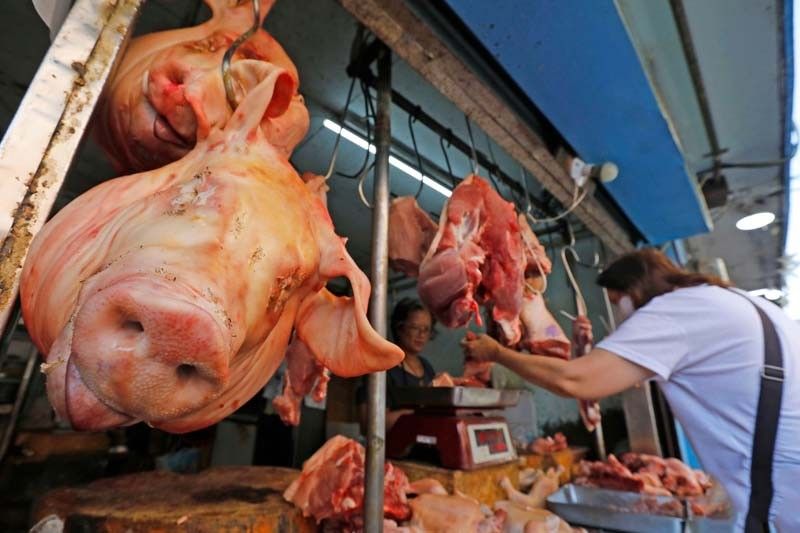Pork shortage looms due to ASF

MANILA, Philippines — A possible shortage of local pork supply looms in June amid the spread of African swine fever (ASF) in the country, the Bureau of Animal Industry (BAI) warned yesterday.
During the Price and Volume Watch for Livestock and Poultry Meeting in Quezon City, National Livestock Program director Ruth Miclat-Sonaco said there will be a pork supply shortage of 46,104 metric tons in June compared to the demand of 145,849 MT.
Miclat-Sonaco said the shortage in June is projected to last at least 39 days.
But as early as next month, the country is projected to experience a possible deficiency in pork supply of at least 11 days or a shortfall of at least 56,180 MT of pork, she showed in her presentation.
Agriculture Assistant Secretary and spokesperson Kristine Evangelista said the Department of Agriculture (DA) is still verifying the data provided by the BAI.
“We are still discussing how to fix it based on more inputs, data coming from the LGUs (local government units). We are still improving our data, vetting it with our stakeholders,” Evangelista said.
On the part of farmers, Samahang Industriya ng Agrikultura (SINAG) executive director Jayson Cainglet contradicted the figures presented by the BAI.
“We have a shortage. We acknowledge that, but we don’t know how they came up with the 39 days shortage in the supply,” Cainglet said.
He said there was a 30 percent reduction of hog raisers due to the impact of ASF and the decision of backyard raisers to stop operations.
“The number of backyard growers decreased as before they comprised at least 60 to 65 percent of the total volume of pork but now it is 50 percent for backyard raisers and 50 percent for commercial raisers as many backyard raisers decided to stop even before the ASF,” he said.
Spike in pork prices
Cainglet maintained that it is the middlemen and traders who cause the spike in retail prices of pork products since the farmgate price remains at P220 per kilo.
“There is really a disconnect between the farmgate price and retail price as the farmgate price is only at P220 per kilo. Retail price of pork kasim should only range between P340 and P350 per kilo. The DA should address this,” the SINAG official said.
Meanwhile, Evangelista gave assurance that the DA is already looking into the cause of the spike in pork prices in the markets.
“We are verifying the supply situation as the pork being supplied in Metro Manila comes from Region 4-A, Region 4-B and Region 3 so that we can come up with proper intervention as we monitor the increase in the prices of pork,” she said.
Based on the monitoring of the DA on Thursday, the retail price of pork liempo ranged between P360 and P420 per kilo and pork kasim, between P270 and P340 per kilo.
Based on the data from BAI, as of March 5, 2023, at least 15 regions are affected by ASF.
According to BAI, the regions affected by the outbreak of the ASF include Cordillera Administrative Region, Regions 1 (Ilocos), 2 (Cagayan Valley), 3 (Central Luzon), 4-A (Calabarzon), 4-B (MimaropaI), 5 (Bicol), 6 (Western Visayas), 7 (Central Visayas), 8 (Eastern Visayas), 9 (Zamboanga peninsula), 10 (Northern Mindanao), 11 (Davao), 12 (Soccsksargen) and 13 (Caraga).
Only the Bangsamoro Autonomous Region in Muslim Mindanao is ASF free.
This represents a 100 percent increase in terms of regions from last Feb. 2 with only seven affected. The BAI added that the outbreak is now recorded in 54 provinces, compared with only 12 last month.
Meat imports up in February
The Philippines shipped more pork products last month, but higher chicken imports mainly drove the overall meat importation to 166.13 million kilos in the first two months of the year, BAI data showed. This was 2.47 percent higher than the 162.12 million kilos shipped in the same period last year. Pork was the top major imported meat for the period, accounting for 41.89 percent of the total at 69.59 million kilos – lower by 14.41 percent from the 81.3 million kilos shipped in the same months last year.
Pork offal or internal organs accounted for highest imports of pork products at 35.48 million kilos, followed by pork cuts at 16.07 million kilos. — Danessa Rivera
- Latest
- Trending





























